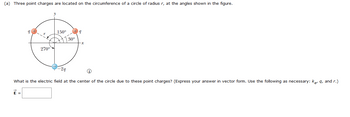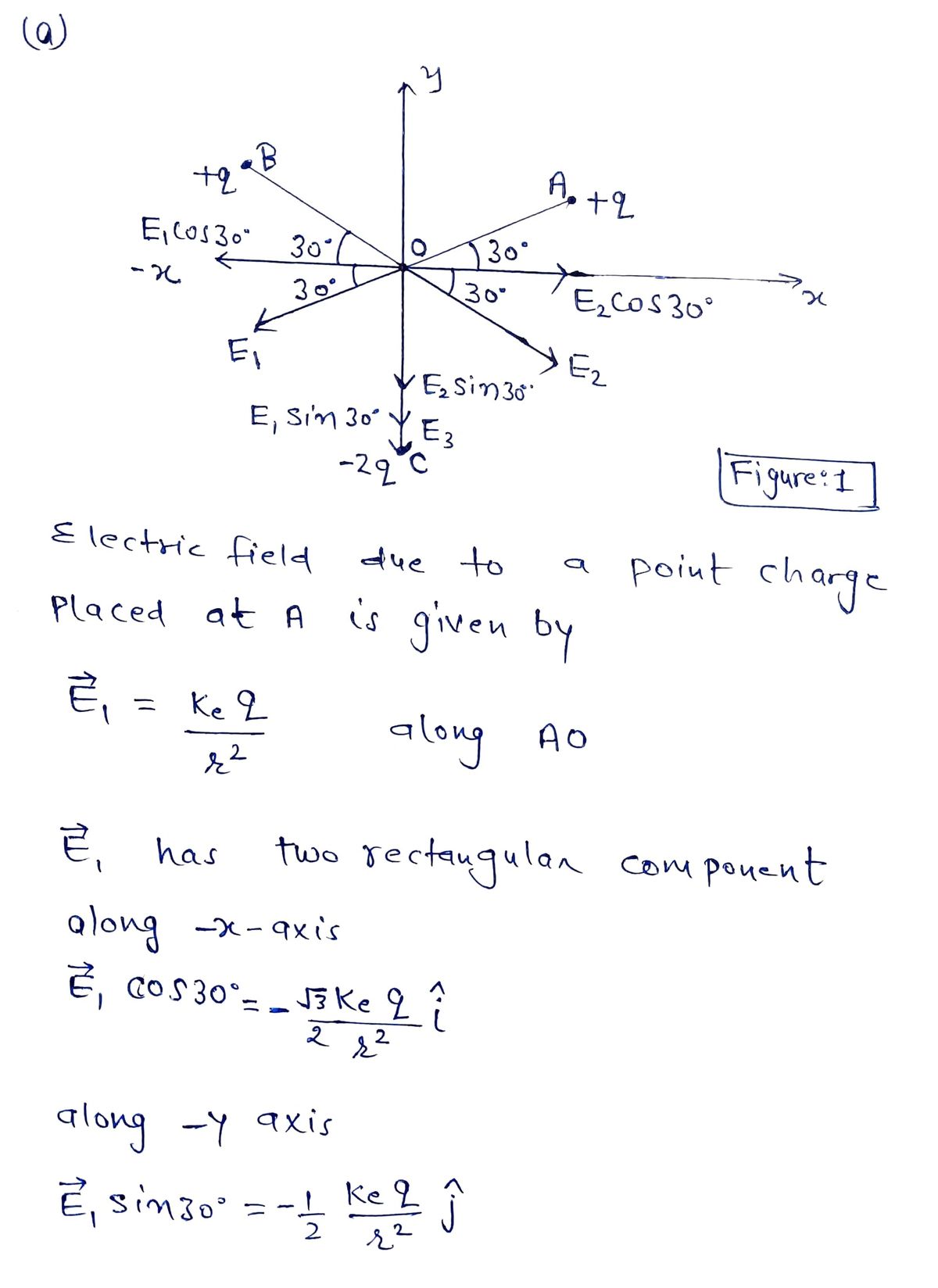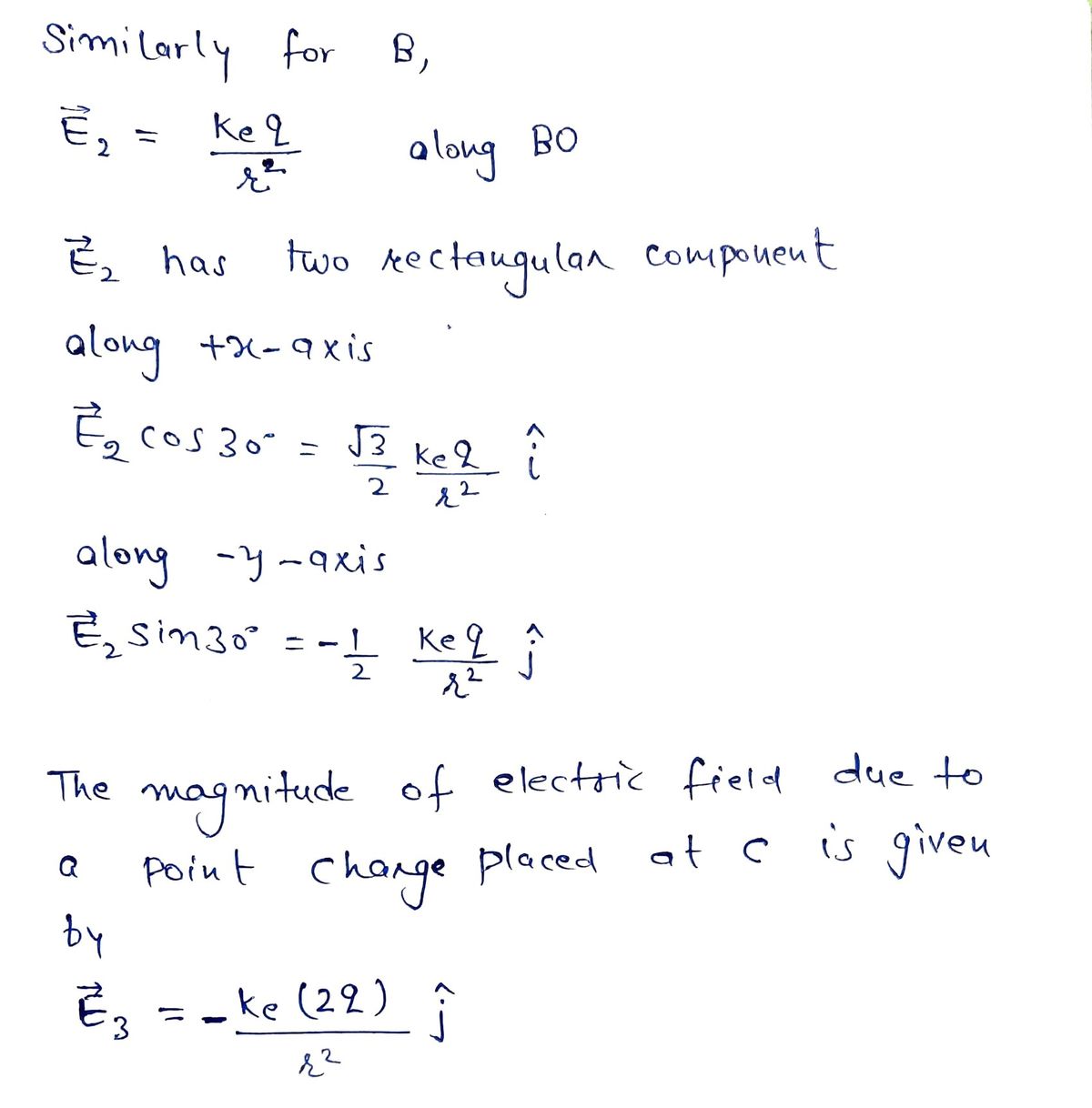
College Physics
11th Edition
ISBN: 9781305952300
Author: Raymond A. Serway, Chris Vuille
Publisher: Cengage Learning
expand_more
expand_more
format_list_bulleted
Concept explainers
Question

Transcribed Image Text:(a) Three point charges are located on the circumference of a circle of radius r, at the angles shown in the figure.
9
270⁰
150°
30°
9
x
-2q
☹
What is the electric field at the center of the circle due to these point charges? (Express your answer in vector form. Use the following as necessary: ke, q, and r.)
Expert Solution
arrow_forward
Step 1


Step by stepSolved in 2 steps with 3 images

Knowledge Booster
Learn more about
Need a deep-dive on the concept behind this application? Look no further. Learn more about this topic, physics and related others by exploring similar questions and additional content below.Similar questions
- There are three static charges (Q1 = 4 nC, Q2 = - 4 nCn and Q3 = - 4nC) located in different locations of Fig. 1. Calculate the net electric field at the given point P.arrow_forwardImagine that in a region in space you detect a spherical symmetric electric field that increases quadratically with the distance from the center, E (r) = a · r2 . er, where a is a constant. How is the the charge distributed in that region, i.e. find p (r). increases linearly radially outward decreases linearly radially outward uniformarrow_forwardcan you answer all parts pleasearrow_forward
- Give an expression for the electric field strength ?E at a point in terms of the charge ?q and distance ?r from the charge to that point. Use ?k for 14??014πε0 (i.e. ?≡14??0k≡14πε0). Use the following notation (without the quotes): "/" for division, "*" for multiplication, "+" an "-" as usual. For powers used "^2", while for square root use "sqrt". To indicate that square root applies to the whole expression use brackets - for example, for ??‾‾‾‾√AB use sqrt(A*B). For Greek letters such as ?π, ?α etc. use pi, alpha. For example to get 1??2???‾‾‾‾√1πA2BAB use 1/pi*A^2/B*sqrt(AB). Please use the exact variables given in the conditions of the problem: e.g if ?L is given, then do not use ?l.arrow_forwardthe point charges are located at the corners of an equilateral triangle 24cm on a side. find the magnitude of the electric field. in newtons per coulomb at the center of the triangle configuration of charges given that Qa=2.9 nC, Qb+-8.9nC, and Qc=1.7nC,also find the direction of the electric fieldin degrees below the right pointing horizontalarrow_forwardA total charge of Q = 60 microC is split into three equal point charges located 120 deg apart on a circle defined by a radius of 4 [m] and lying in the x-y plane. Find the magnitude of the electric field at the center of the three charges. Please, provide a detailed answer with explanation and drawings to understand. Thank you in advance!arrow_forward
- (a) Determine the electric field strength at a point 1.00 cm to the left of the middle charge shown in the figure below. (Enter the magnitude of the electric field only.) (b) If a charge of −6.49 µC is placed at this point, what are the magnitude and direction of the force on it?arrow_forwardThis is an approximate model of a water molecule. Point charges q1 and q2 of -1.00 x 10-19 C and 1.00 x 10-19 C, respectively, are placed 0.600 x 10-12 m apart. Thus d = 0.300 x 10-12 m in fig. 2 below, D= 0.600 x 10-12 m At point b, what must be the y-component Eynet of the net electric field due to the two charges? Show work. At point b, what is the x-component Exnet of the net electric field due to the two charges? At point b, what is the direction of the net electric field due to the two charges? Indicate this direction by drawing an arrow in fig. 2 with its tail at point b. At point b, what is the magnitude of the net electric field due to the two charges? What is the relationship between your answer here and your answer to part (e)?arrow_forward
arrow_back_ios
arrow_forward_ios
Recommended textbooks for you
 College PhysicsPhysicsISBN:9781305952300Author:Raymond A. Serway, Chris VuillePublisher:Cengage Learning
College PhysicsPhysicsISBN:9781305952300Author:Raymond A. Serway, Chris VuillePublisher:Cengage Learning University Physics (14th Edition)PhysicsISBN:9780133969290Author:Hugh D. Young, Roger A. FreedmanPublisher:PEARSON
University Physics (14th Edition)PhysicsISBN:9780133969290Author:Hugh D. Young, Roger A. FreedmanPublisher:PEARSON Introduction To Quantum MechanicsPhysicsISBN:9781107189638Author:Griffiths, David J., Schroeter, Darrell F.Publisher:Cambridge University Press
Introduction To Quantum MechanicsPhysicsISBN:9781107189638Author:Griffiths, David J., Schroeter, Darrell F.Publisher:Cambridge University Press Physics for Scientists and EngineersPhysicsISBN:9781337553278Author:Raymond A. Serway, John W. JewettPublisher:Cengage Learning
Physics for Scientists and EngineersPhysicsISBN:9781337553278Author:Raymond A. Serway, John W. JewettPublisher:Cengage Learning Lecture- Tutorials for Introductory AstronomyPhysicsISBN:9780321820464Author:Edward E. Prather, Tim P. Slater, Jeff P. Adams, Gina BrissendenPublisher:Addison-Wesley
Lecture- Tutorials for Introductory AstronomyPhysicsISBN:9780321820464Author:Edward E. Prather, Tim P. Slater, Jeff P. Adams, Gina BrissendenPublisher:Addison-Wesley College Physics: A Strategic Approach (4th Editio...PhysicsISBN:9780134609034Author:Randall D. Knight (Professor Emeritus), Brian Jones, Stuart FieldPublisher:PEARSON
College Physics: A Strategic Approach (4th Editio...PhysicsISBN:9780134609034Author:Randall D. Knight (Professor Emeritus), Brian Jones, Stuart FieldPublisher:PEARSON

College Physics
Physics
ISBN:9781305952300
Author:Raymond A. Serway, Chris Vuille
Publisher:Cengage Learning

University Physics (14th Edition)
Physics
ISBN:9780133969290
Author:Hugh D. Young, Roger A. Freedman
Publisher:PEARSON

Introduction To Quantum Mechanics
Physics
ISBN:9781107189638
Author:Griffiths, David J., Schroeter, Darrell F.
Publisher:Cambridge University Press

Physics for Scientists and Engineers
Physics
ISBN:9781337553278
Author:Raymond A. Serway, John W. Jewett
Publisher:Cengage Learning

Lecture- Tutorials for Introductory Astronomy
Physics
ISBN:9780321820464
Author:Edward E. Prather, Tim P. Slater, Jeff P. Adams, Gina Brissenden
Publisher:Addison-Wesley

College Physics: A Strategic Approach (4th Editio...
Physics
ISBN:9780134609034
Author:Randall D. Knight (Professor Emeritus), Brian Jones, Stuart Field
Publisher:PEARSON